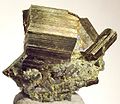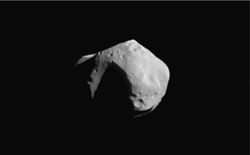CI chondrites, also called C1 chondrites or Ivuna-type carbonaceous chondrites, are a group of rare carbonaceous chondrites, a type of stony meteorite...
91 KB (10,007 words) - 14:17, 27 May 2025
A chondrite /ˈkɒndraɪt/ is a stony (non-metallic) meteorite that has not been modified by either melting or differentiation of the parent body. They are...
47 KB (5,162 words) - 13:08, 28 April 2025
their abundance in CI chondrites). In this sense, they are chemically the most primitive known meteorites. [citation needed] CI chondrites typically contain...
32 KB (3,313 words) - 14:36, 8 June 2025
Earth's outer core (section CI chondrites)
on seismic measurements, models of Earth's accretion, and carbonaceous chondrite meteorite comparisons with bulk silicate Earth (BSE). Recent estimates...
24 KB (2,405 words) - 20:51, 9 June 2025
162173 Ryugu (section Similarities to CI chondrites)
spectrally different inclusions. The inclusions appear similar to CI chondrites. An unanticipated side effect from the Hayabusa2 thrusters revealed...
63 KB (5,797 words) - 13:46, 13 May 2025
Asteroidal water (section CI chondrites)
J (Jul 2010). "Carbonates in CM chondrites: Complex formation histories and comparison to carbonates in CI chondrites". Meteoritics & Planetary Science...
76 KB (8,996 words) - 18:56, 28 October 2024
definition was found: C-chondrites contain proportionally higher magnesium than ordinary chondrites. The C-chondrites subdivide into CI, CM, CO, CV, CK, CR...
75 KB (8,256 words) - 17:48, 6 May 2025
Chondrule (category Chondrite meteorites)
CI chondrites which, paradoxically, do not contain any chondrules despite their designation as chondrites, whereas ordinary and enstatite chondrites contain...
10 KB (1,121 words) - 21:40, 23 April 2025
indicated a correspondence with the CI and/or CM carbonaceous chondrite meteorites, including carbonaceous-chondrite mineral magnetite. Magnetite, a spectrally...
105 KB (9,256 words) - 01:10, 18 June 2025
group, CI chondrites are considered a better match for the composition of the early Solar System. Moreover, the chemical analysis of CI chondrites is more...
57 KB (7,049 words) - 16:33, 20 April 2025
interpretation of quantum mechanics Cubic inch, a unit of volume CI group, a type of carbonaceous chondrite meteorite Carrier interferometry, a radio and optical...
6 KB (698 words) - 21:21, 23 October 2024
Stony meteorites Chondrites Carbonaceous chondrite class CI chondrites (Ivuna-like) group CM-CO chondrite (mini-chondrule) clan CM chondrite (Mighei-like)...
14 KB (1,580 words) - 12:47, 3 May 2025
Bischoff, Adolf (1994). "Chemistry, petrography, and mineralogy of the Tonk CI chondrite: Preliminary results". Meteoritics. 29 (4): 462–463. Ministry of Panchayati...
12 KB (786 words) - 06:42, 26 April 2025
earth. Cubanite has been found in carbonaceous chondrite meteorites, specifically class CI-chondrites, as well as in cometary samples from NASA's Stardust...
10 KB (900 words) - 18:50, 27 May 2025
Orgueil (meteorite) (category Chondrite meteorites)
University Press Orgueil is one of five known meteorites belonging to the CI chondrite group (see meteorites classification), and is the largest (14 kilograms...
11 KB (964 words) - 00:05, 21 February 2025
evolution. Ratios larger or smaller than compared with that in the sun or CI chondrites, which are used as proxy for the sun, indicate that significant hydrodynamic...
17 KB (2,164 words) - 14:26, 1 June 2025
Tonk meteorite (category Chondrite meteorites)
22 January 1911. It is one of five known meteorites belonging to the CI chondrite group. This group is remarkable for having an elemental distribution...
4 KB (366 words) - 15:22, 2 October 2024
have a carbon concentration that is five to ten times less than in CI chondrites, a form of meteor that is believed to represent the composition of the...
20 KB (2,186 words) - 23:14, 23 January 2024
of the Sun and the Jovian gas planets. Certain type of meteorites, CI-chondrites, have chemical compositions that are almost identical to the solar photosphere...
3 KB (962 words) - 15:35, 1 June 2025
Alais meteorite (category Chondrite meteorites)
France. The meteorite is one of five known meteorites belonging to the CI chondrite group. This group is remarkable for having an elemental distribution...
10 KB (829 words) - 14:54, 10 February 2025
Murchison meteorite (category Chondrite meteorites)
CM chondrites, together with the CI group, are rich in carbon and are among the most chemically primitive meteorites. Like other CM chondrites, Murchison...
23 KB (2,115 words) - 19:07, 17 June 2025
isotopic compositions with signatures similar to those of CI and CM carbonaceous chondrites were found in Tunguska peat layers dating from the TE (Kolesnikov...
74 KB (8,909 words) - 13:46, 12 June 2025
Wold Cottage meteorite (category Chondrite meteorites)
reported present. Modern science records the meteorite as a L6 ordinary chondrite. The Wold Cottage meteorite was the largest meteorite observed to fall...
9 KB (893 words) - 18:56, 14 June 2024
matches ancient eucrite chondrites, which originate from the asteroid Vesta in the outer asteroid belt. CI, CM, and eucrite chondrites are believed to have...
46 KB (5,517 words) - 01:06, 17 May 2025
this class have spectra very similar to those of carbonaceous chondrite meteorites (types CI and CM). The latter are very close in chemical composition to...
6 KB (636 words) - 20:35, 18 February 2025
asteroids can be reproduced through a combination of 31% CI and 49% CM groups of carbonaceous chondrite meteorites, plus 20% Tagish lake meteorites, after undergoing...
6 KB (709 words) - 07:51, 23 October 2024
Tagish Lake (meteorite) (category Chondrite meteorites)
some similarities to the two most primitive carbonaceous chondrite types, the CI and CM chondrites; it is nevertheless quite distinct from either of them...
17 KB (1,846 words) - 14:03, 13 April 2025
water to remain in the lithic matrix. The carbonaceous chondrite class is often water-rich, and the CI sub group are as much as 22% water. Notable nearby...
10 KB (945 words) - 03:38, 19 June 2025
1952). "Solving the Riddle of Chubb Crater". National Geographic Magazine. CI (1): 1–31. "Buried Missile". Time. 24 September 1951. Archived from the original...
10 KB (1,138 words) - 08:03, 5 March 2025
1815 Mount Tambora eruption 2.33×1020 J Kinetic energy of a carbonaceous chondrite meteor 1 km in diameter striking Earth's surface at 20 km/s. Such an impact...
140 KB (9,719 words) - 20:01, 9 June 2025





















